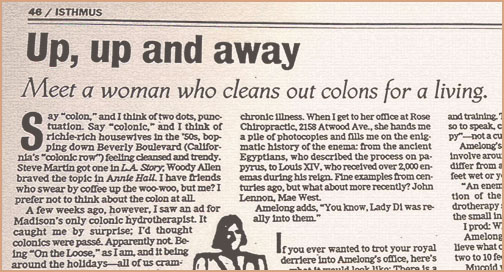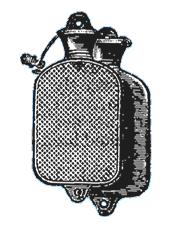A Look Back: 1999 Interview with Kristina Amelong, CCT, CNC
Isthmus Newspaper | Madison, WI

Up, up and away
Meet a woman who cleans out colons for a living
by Tenaya Darlington
December 17, 1999
Say "colon" and I think of two dots, punctuation. Say "colonic" and I think of richie-rich housewives in the '50s, bopping down Beverly Boulevard (California's "colonic row") feeling cleansed and trendy. Steve Martin got one in L.A. Story; Woody Allen braved the topic in Annie Hall. I have friends who swear by coffee up the woo-woo, but me? I prefer not to think about the colon at all.
A few weeks ago, however, I saw an ad for Madison's only colonic hydrotherapist. It caught me by surprise; I'd thought colonics were passé. Apparently not. Being "On the Loose," as I am, and it being around the holidays — all of us cramming meat and mashed potatoes down our darkest pathways — I thought I'd have a field day.
Before I go any further, I should tell you that Kristina Amelong, Madison's premier colonic hydrotherapist, was probably one of my most enthusiastic interviewees ever. At 35, she's an energetic and sprightly east-sider with long hair and little glasses. If you might think she was a yogi (she's got that high-pro glow) or associate her with a bookstore (she looks scholarly). It would never occur to you to think: This woman talks about stool for a living.
Amelong began studying to be a colonic hydrotherapist four years ago, after battling a chronic illness. When I get to her office at Rose Chiropractic, 2158 Atwood Ave., she hands me a pile of photocopies and fills me in on the enigmatic history of the enema: from the ancient Egyptians, who described the process on papyrus, to Louis XIV, who received over 2,000 enemas during his reign. Fine examples from centuries ago, but what about more recently? John Lennon, Mae West.

Amelong adds, "You know, Lady Di was really into them."
If you ever wanted to trot your royal derriere into Amelong's office, here's what it would look like: There is a bed covered in flannel sheets next to two FDA-approved particle filters that remove chemicals from the water she uses. On the table by the bed is a bag of sterilized, disposable tubing. There are diagrams on the walls, a scale on the floor, yet it doesn't feel overwhelmingly medical. The walls are pale purple. Call it hyacinth. There are books to read, from the children's classic Everyone Poops to Mother Theresa's autobiography. The vibe is pleasing.
Up until the '60s, Amelong tells me, you could go to your doctor for a colonic. Hospitals and nursing homes had all the equipment. Then laxatives came into vogue. Colonic treatments generated safety concerns. In 1989, the International Association for Colon Hydrotherapy came into being to establish standards for tools and training. Today, colonics are on the upswing, so to speak, carefully couched in "hydrotherapy" — not a cure but a ritual cleansing.
Amelong's treatments last about an hour and involve around 35 gallons of water. How does it differ from an enema? Well, you can get your feet wet or you can dive in all the way.
"An enema only reaches the first third section of the colon," Amelong says. "A hydrotherapy session reaches all the way into the small intestine, which is 35 feet in itself."
I prod: What happens? What are the results?
Amelong's eyes get big. "You wouldn't believe what comes out of people," she says. "I see two to 10 feet of mucoid plaque a week."
Mucoid what?
Amelong opens a book full of photos: Gloved hands hold up chains of undigested material dislodged from the far recesses of the small intestine. To my eye, they look like necklaces of coal.
"I've seen 120 feet of this stuff come out of one person," she says, adding merrily, "It's so much fun."
For those of you who are still with me, you'll be glad to know that Amelong doesn't handle this "stuff" herself. If you're a patient, you can watch it through a little viewing panel on the side of the machine. "Getting rid of all this definitely makes people feel more energetic," she stresses. "You can really see their skin glow."
Amelong's average hydrotherapy patient is a woman in her 30s. "I think men are more scared of it," she laughs. Patients come in for a variety of reasons, from sinus infection to chronic fatigue, even snoring. While she stresses that colonic hydrotherapy is not a cure, she says, "If you give the body the right conditions, it can heal itself. And that's what I'm about." She cites rectal cancer as the number-two cancer killer among whites in America. She points to food additives and pesticides, arguing, "We're eating in ways we weren't meant to eat, and we're asking the body to just deal with it."
A single colonic costs $60. For a full cleansing, Amelong recommends a series of three colonic treatments in combination with fasting, which would run the tab up to $150 — not bad if you consider that Amelong stays on call to provide support. "Fasting is serious business," she says. "I provide full-service support for people, and that means emotional and nutritional support."
There's just one looming question for me: Does getting a colonic hurt? Amelong offers the following description: "It's not uncomfortable. Sometimes you feel crampy, but mostly there's no pain involved. The more toxic you are, the more cramping you feel."
Standing in Amelong's office, I'm closer to the world of the colon than ever before. There are colon posters taped to the walls, books about the colon on every shelf, and then there's Amelong herself — the picture of good health.
I never thought I'd be saying this, especially in a newspaper, but getting a colonic sounded great. I wondered why people weren't lining up outside her door? Bottoms up!